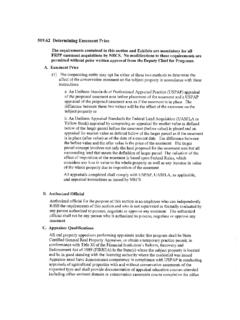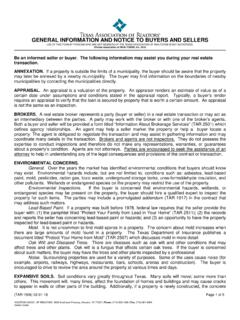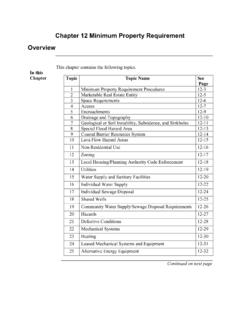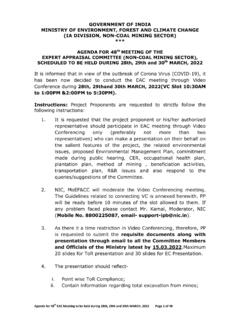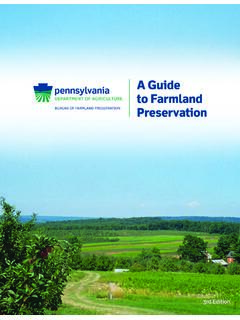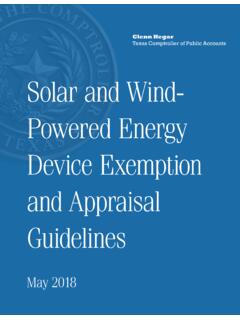Transcription of Conservation Easement Audit Techniques Guide
1 Conservation Easement Audit Techniques Guide Revision Date January 24, 2018. Note: This document is not an official pronouncement of the law or position of The National Register of Historic Places the Service and cannot be used, cited, or relied upon as such. This Guide is current through the publication date. Contents Chapter 1: Introduction to Conservation 5. Statement of Purpose .. 5. Overview .. 5. Getting Started .. 6. Definition of Conservation Easement .. 6. Tax 7. Chapter 2: Statutory Requirements for All Charitable Contributions .. 7. Overview .. 7. Charitable Contribution Definition .. 7. Real Estate 8. Partial Interest Rule.
2 8. Conditional Gifts .. 8. Earmarking .. 9. Year of 9. Substantiation of Noncash 9. Amount of 10. Chapter 3: Qualified Conservation Contribution .. 10. Overview .. 10. Qualified Real Property Interest .. 10. Qualified 11. Conservation Purpose .. 11. Perpetuity .. 11. Chapter 4: Qualified Organization .. 14. Overview .. 14. Qualified 14. Commitment & Resources .. 14. Cash Contributions .. 15. Chapter 5: Conservation 16. Overview .. 16. Land for Outdoor Recreation or 17. Relatively Natural Habitat or Ecosystem .. 17. Page 1. Open Space .. 18. Historically Important Land or Structure .. 20. Public Access .. 22. Inconsistent Uses.
3 22. Baseline 23. Chapter 6: Substantiation .. 24. Overview .. 24. Contemporaneous Written Acknowledgment .. 24. Form 8283, Noncash Charitable 27. Qualified appraisal .. 28. Fa ade Easement Filing Fee (Registered Historic District Only) .. 29. Baseline 30. Exhibit 6-1 - Substantiation Requirements .. 30. Chapter 7: Qualified appraisal Requirements .. 31. Overview .. 31. Qualified appraisal .. 31. Qualified Appraiser .. 32. Generally Accepted appraisal 33. appraisal Fees .. 34. Chapter 8: Amount of Deduction .. 35. Overview .. 35. Percentage Limitations .. 35. Basis 37. Contributions of Appreciated Property .. 38. Bargain Sale.
4 39. Quid Pro Quo and Charitable Intent .. 40. Rehabilitation Tax Credit .. 41. Chapter 9: Valuation of Conservation easements .. 41. Overview .. 41. Valuation 42. Valuation Date .. 43. Fair Market Value (FMV) .. 43. Market Analysis .. 45. Highest and Best Use (HBU) .. 46. Methodology .. 47. Page 2. Transferable Development Rights (TDRs).. 50. Chapter 10: Preplanning the Examination .. 51. Overview .. 51. Review of Return .. 51. Internal Sources of Information .. 55. External Sources of Information .. 56. Interviews .. 59. Information Document Requests .. 59. Valuation Expert Involvement .. 60. Consultation with Counsel .. 62. Coordination with TEGE.
5 63. Chapter 11: Conducting the Examination .. 63. Overview .. 63. Interviews .. 64. Property Inspection .. 65. Review of Documents .. 66. Third-Party Contacts .. 75. Chapter 12: Concluding the Examination .. 78. Overview .. 78. Issue Identification .. 78. Report Writing .. 80. Closing Conference .. 82. Taxpayer Protests .. 82. Exhibit 12-1 Conservation Easement Issue Identification Worksheet .. 83. Chapter 13: 87. Overview .. 87. Accuracy-Related 88. IRC 6662(c) Negligence or Disregard of Rules or 88. IRC 6662(d) Substantial Understatement of Income Tax .. 88. IRC 6662(e) Valuation Misstatements .. 89. IRC 6663 Civil Fraud Penalties.
6 90. IRC 6664 Reasonable Cause 90. Return Preparers-IRC 6694 .. 91. Promoters-IRC 6700 and 6701 .. 92. Appraisers-IRC 6695A Substantial and Gross Valuation Misstatements Attributable to Page 3. Incorrect Appraisals .. 92. Chapter 14: State Tax Credits .. 93. Overview .. 93. State Tax Credit Programs .. 93. Sale of State Tax 95. Page 4. Chapter 1: Introduction to Conservation easements Statement of Purpose The purpose of this Audit Techniques Guide (ATG) is to provide guidance for the examination of charitable contributions of Conservation easements . Users of this Guide will learn about the general requirements for charitable contributions and additional requirements for contributions of Conservation easements .
7 This ATG includes examination Techniques and an overview of the valuation of Conservation easements . It also includes a discussion of penalties, which may be applicable to taxpayers and others involved in the Conservation Easement transaction. This Guide is not designed to be all-inclusive. It is not a comprehensive training manual on the valuation of Conservation easements . Overview To be deductible, donated Conservation easements must be legally binding, permanent restrictions on the use, modification and development of property such as parks, wetlands, farmland, forest land, scenic areas, historic land or historic structures.
8 The restrictions on the property must be in perpetuity. Current and future owners of the Easement and the underlying property must all be bound by the terms of the Conservation Easement deed. The general rule is that no charitable contribution deduction is allowed for a transfer of property of less than the taxpayer's entire interest in the property. 170(f)(3). Section 170(f)(3)(B)(iii) provides an exception to the partial interest rule for contributions of qualified Conservation easements . Internal Revenue Code (IRC) 170(h) states that a qualified Conservation contribution is a contribution of a qualified real property interest ( , a restriction granted in perpetuity on the use which may be made of the real property) to a qualified organization exclusively for Conservation purposes.
9 The IRC and accompanying Treasury regulations outline the requirements that must be met before a contribution is deductible. Qualified organizations that accept Conservation easements must have a commitment to protect the Conservation purposes of the donation in perpetuity and must have sufficient resources to enforce compliance with the terms of the Easement deed. IRC 170(h)(4)(A) specifies the four deductible types of Conservation contributions: Preservation of land areas for outdoor recreation by, or the education of, the general public. Protection of a relatively natural habitat of fish, wildlife, or plants, or similar ecosystem.
10 Preservation of open space (including farmland and forest land). Preservation of a historically important land area or a certified historic structure. Page 5. The donation of a Conservation Easement that meets all statutory and regulatory requirements, including specific substantiation requirements, can be claimed as a charitable contribution deduction. The value of a Conservation Easement must be determined in a qualified appraisal prepared and signed by a qualified appraiser. The value of the contribution is the fair market value (FMV) of the Conservation Easement at the time of the contribution. To the extent there is a substantial record of sales of Conservation easements comparable to the donated Easement , the FMV is based on the sales price of such comparables.










